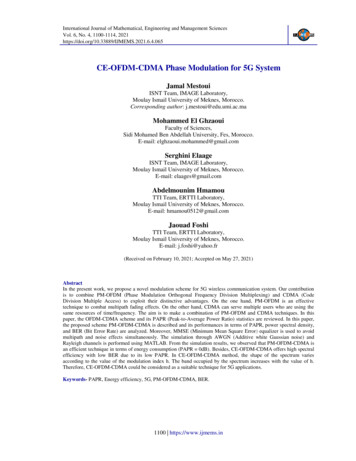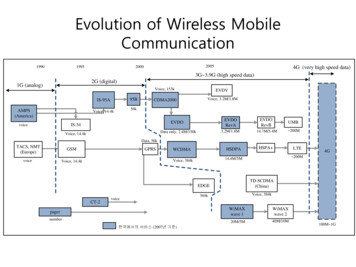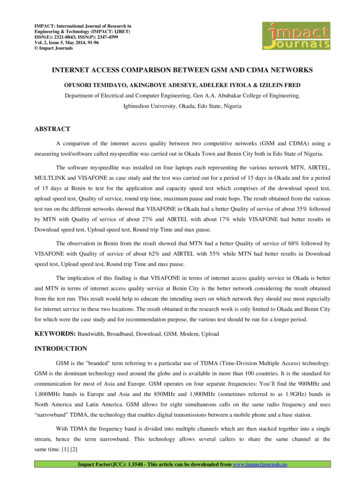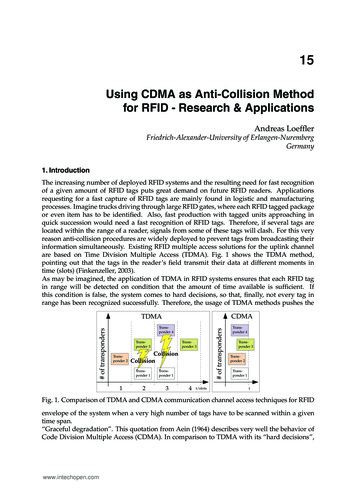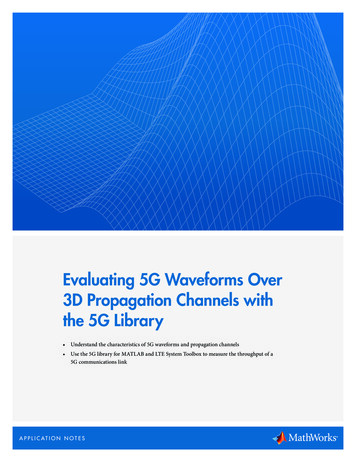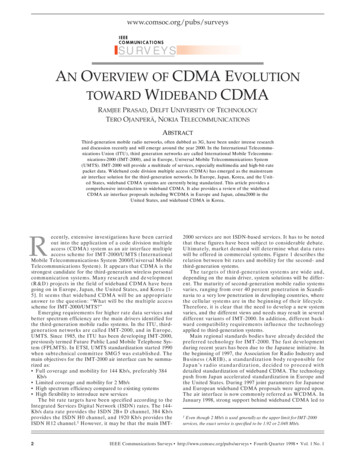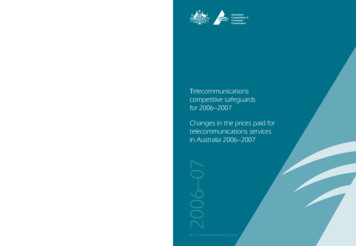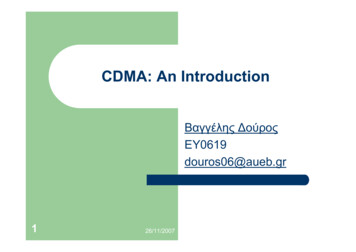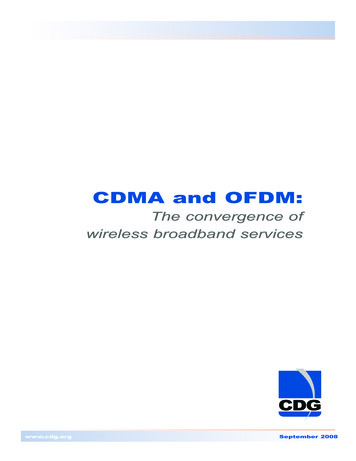
Transcription
CDMA and OFDM:The convergence ofwireless broadband serviceswww.cdg.orgSeptember 2008
CDMA AND OFDMWireless Broadband Services1. IntroductionUp until the end of the 20th century, there was a fairly clear division between the cellular industry and other telecommunicationindustries which offered basic telephone, television, radio, computer and Internet services. Most mobile operators usedsecond generation (2G) digital wireless technologies to enable voice communications and limited data services, while mostwireline, cable and satellite systems provided the bulk of the other telecommunication services. In spite of its initial limitations,cellular communications have been a tremendous success, surpassing fixed line connections worldwide in 2001, just 12years after its market introduction. This has been especially evident in developing markets where, due to their lowerdeployment costs and greater network flexibility, wireless technologies have become the primary means of communicationfor millions of people, spurring the economic and social development of these markets.Since the beginning of the 21st century, there has been a dramatic shift in the market dynamics of telecommunicationsservices. With the introduction of third generation (3G) IMT-2000 technologies based on CDMA, wireless operators havebeen able to offer high-quality voice services as well as broadband Internet access and multimedia services, blurring theboundaries between the telecom industries. Service providers and regulators across both developed and developing marketshave been quick to adopt and promote the technologies, and in the 7 years since the deployment of the first 3G network(based on CDMA2000 ) in 2000, over 460 operators have launched CDMA2000 and WCDMA systems surpassing 685million users in June 2008. The adoption of 3G mobile broadband technologies, based on CDMA2000 1xEV-DO andHSPA, has also been accelerating, reaching 335 commercial systems serving more than 131 million users in 120 countriesin a little over 5 years.Yet again, the wireless industry stands at the crossroads of selecting capabilities and services to take it well into the future.These new dimensions include: the proliferation of voice, video, television, broadband Internet and value-added data services;integration amongst wireless and fixed networks to enable the seamless delivery of these services over multiple networks;improved user experience and economics; and convergence of industries such as telecommunications, information andbroadcasting.This white paper discusses the future role of CDMA2000 in an environment where new wireless local area networks(WLAN), wide area networks (WAN) and mobile broadcast networks are now being considered. In Section 3, the paperhighlights the CDMA2000 migration, beginning with IS-95, through 1X, EV-DO and beyond. With this basis of understanding,the paper then examines the advantages of multi-carrier EV-DO Rev. B, as well as the benefits of Orthogonal FrequencyDivision Multiplexing (OFDM)1 technologies for certain applications.Convergence will play a major role in next-generation wireless networks. Section 4 examines convergence at the device andnetwork layer and how it will allow wireless service providers to pick and choose the most appropriate network technology forthe given application. The paper concludes with an analysis of the potential deployment scenarios for OFDM-based nextgeneration mobile broadband solutions as a complement to 3G CDMA solutions.1 Includes Orthogonal Frequency Division Multiple Access Technologies (OFDMA)www.cdg.org2
CDMA AND OFDMWireless Broadband Services2. Next-Generation Mobile Broadband TechnologiesThe next-generation of IMT systems based on CDMA and OFDM, as well as broadcast technologies, will be key enablersof the transition to the next dimension of wireless broadband capabilities and services. In particular, mobile broadbandtechnologies such as CDMA2000 EV-DO Revision B (Rev. B), HSPA , Long Term Evolution (LTE), and Mobile WiMAX(802.16m) will support multi-megabit-per-second data delivery to users, carrier-grade VoIP and other real-time and broadbandintensive applications. For specific bandwidth-intensive applications such as multicasting and broadcasting, OFDM-basedtechnologies such as DVB-H, FLO, ISDB-T, S-DMB and T-DBM have been commercialized since 2006.FIGURE 1CDMA2000 RoadmapWith Complementary Mobile Broadcast and Broadband SolutionsExisting 3G cellular technologies, including CDMA2000 1X/EV-DO, WCDMA/HSPA, and TD-SCDMA, utilize CDMA as thecore radio access technology. Since their first market introduction, they have evolved to deliver higher capacities, throughputs and efficiencies to support the growing usage of increasingly bandwidth-intensive data services. In narrow bandwidthallocations (up to 5 MHz), Rev. A and Rev. B, HSPA and HSPA can achieve some of the highest data throughputs possiblein a given amount of spectrum. With wider radio channels (more than 10 MHz), OFDM-based technologies such as LTEand Mobile WiMAX have emerged as viable options to deliver wider-bandwidth mobile broadband services.For narrowband deployments (up to 5 MHz), CDMA technologies can achievesome of the highest data throughputs possible, while OFDM technologies can offer asimpler implementation within wider radio channels (more than 10 MHz)www.cdg.org3
CDMA AND OFDMWireless Broadband ServicesBoth 3G CDMA and OFDM-based technologies provide the spectral efficiencies, network capacities and latencies necessaryto support mobile television and rich broadband services of the future. Yet, depending upon the market scenario they caneither complement or compete against each other. Each technology has its own technical merits.Considering the significant market momentum and large economies of scale and scope of 3G CDMA technologies, theywill continue to be the leading platform for mobile communications, including next-generation broadband services, wellbeyond the year 2020. Nevertheless, some incumbent operators and new service providers are considering the purchaseof additional spectrum and deployment of OFDM-based systems.3G CDMA technologies will continue to be the leading platformfor mobile communications well beyond the year 2020Regardless of the operator's approach and existing technology roadmap, it is becoming evident that a "one network fits all"strategy will not suffice in future competitive markets. Selecting alternate technologies will be very dependent upon anoperator's unique set of circumstances, including market opportunities, assigned licenses, available spectrum, previoustechnology selections, vendor relationships and propensity for risk. In other words, service providers will choose the pathand technologies that best meets their market and economic requirements.For more than a dozen years, the CDMA technology roadmap has provided operators with technology-leading performancecapabilities and a time-to-market advantage. Thanks to CDMA's forward-and-backward compatible technology upgradeswithin the 1.25 MHz CDMA radio channel, CDMA operators have benefited from the favorable economics of an evolutionary"in-band" solution. As a result they have been able to deploy new technologies and value-added services throughout theirentire network much faster than their competitors.The CDMA2000 family of technologies is strongly positioned to remain a vital component of the convergence revolution.With the commercial availability of CDMA2000 1xEV-DO Revision A (Rev. A) in 2006 and multi-carrier EV-DO, or EV-DORevision B (Rev. B) in 2008 to provide additional capacity via a simple software upgrade, CDMA2000 operators will be ableto offer multi-megabit-per-second average data rates to individual users while leveraging the large economies of scale andscope that the CDMA2000 industry offers.The CDMA2000 family of technologies is strongly positioned to continemeeting existing operator requirements and will play a key role in the future of wirelessand its convergence with other industrieswww.cdg.org4
CDMA AND OFDMWireless Broadband Services3. The CDMA2000 Migration Path Optimizes Performance to DeliverNext-Generation Services While Leveraging Legacy SystemsSince its inception, CDMA2000 has sought to maximize performance and minimize costs by sustaining an evolutionary paththat eliminates the need for expensive "forklift" upgrades. This commitment has resulted in a faster time-to-market, lowercapital and operating expenditures, and a higher degree of backwards compatibility between new and legacy technologieswithin a CDMA2000 network.CDMA2000's In-Band Evolution Towards Advanced Broadband CapabilitiesWhen IS-95 (known by the trade name cdmaOne ) was first commercialized in 1995, it utilized a 1.25 MHz radio channel.By using a narrow radio channel, CDMA operators benefited from greater flexibility in deploying services in existing“in-band” frequency allocations, as compared to wider-bandwidth 10 MHz radio channel solutions.Over the years, CDMA technology has matured with the introduction of a number of new technology advancements thathave enabled increased capabilities, an enhanced user experience and improved economics, including new speechvocoders, advanced antenna techniques, interference cancellation and the aggregation of radio channels. Theseadvancements became available through the publication and commercialization of new global standards such asCDMA2000 1X and CDMA2000 1xEV-DO.CDMA2000 1X, 1xEV-DO Rel. 0 and 1xEV-DO Rev. A (all ITU-approved, IMT-2000 3G technologies) are designed to operate in a single 1.25 MHz channel and allow operators a smooth upgrade to deliver higher performing and more affordableservices. All three technologies have been commercially deployed: 1X was introduced in 2000, Rel. 0 was launched in2002, and Rev. A was commercialized in late 2006.FIGURE 2CDMA2000 Market Maturity and Future Growth*Source: Actual CDMA Development Group**Source: Average of ABI (Jan 2008) and iGR (Mar 2007) subscriber forecastswww.cdg.org5
CDMA AND OFDMWireless Broadband ServicesFIGURE 3EV-DO Market Maturity and Future Growth*Source: Actual CDMA Development Group**Source: Average of Strategy Analytics (Jan 2008), ABI (Jan 2008), Wireless Intelligence (Jan 2008), WCIS (Jan 2008), iGR (Mar 2007)and Yankee Group (Dec 2007) subscriber forecastsRev. A maximizes spectral efficiency to deliver a peak data rate of 3.1 Mbps in the downlink and 1.8 Mbps in the uplink,plus lower latency and advanced QoS mechanisms to support carrier-grade VoIP and other delay-sensitive applications.The use of a 1.25 MHz radio channel, however, limits the maximum data rate that any one user can achieve. Therefore,for CDMA2000 operators looking to deliver additional bandwidth and multi-megabit-per-second data rates economically totheir subscribers while preserving their previous infrastructure investments, an upgrade to multi-carrier Rev. B is theoptimum solution. Rev. B is also a viable solution for Greenfield deployments.For CDMA2000 operators looking to deliver additional bandwidth economically to theirsubscribers and preserving their previous infrastructure investments, an upgrade tomulti-carrier Rev. B is the optimum solutionMulti-Carrier EV-DO Rev. B Builds Upon the Spectral Efficiencies of EV-DO and Aggregates Spectrum to OfferAdvanced Wireless BroadbandEV-DO Rev. B, also an approved IMT-2000 standard, is a multi-carrier implementation of Rev. A that allows operators tocombine several discrete 1.25 MHz carriers through a software upgrade without any degradation of spectral efficiency. Forexample, using three 1.25 MHz carriers (within 5 MHz of spectrum) and a software upgrade to Rev. B, the user peak datarate jumps to 9.3 Mbps in the downlink and 5.4 Mbps in the uplink. With an additional channel card hardware upgrade,the peak data rates will increase further to 14.7 Mbps in the downlink. The additional carrier assignments also increasethe capacity for VoIP communications.www.cdg.org6
CDMA AND OFDMWireless Broadband ServicesThe average data rates advertised for commercial Rev. A networks range from 600 kbps to 1.4 Mbps in the downlink and500 to 800 kbps in the uplink. With a three carrier Rev. B software upgrade implementation, a user should experienceaverage data rates that are three-times higher, up to 4.2 Mbps in the downlink and 2.4 Mbps in the uplink, and even higherwith the hardware upgrade.For the operator that has deployed multiple Rev. A channels, these enhanced capabilities will only require a modest capitalinvestment since a software upgrade to the Rev. A infrastructure is generally all that is required along with new communicationsmodems in the handsets. The operator may also choose to add new Rev. B channel cards for higher performanceimprovements.From the subscriber's perspective, the performance of Rev. B will deliver a much better user experience, including quickernetwork connections and faster downlink and uplink data rates. Rev. A subscribers will also benefit since less networkcapacity will be consumed by the faster Rev. B devices, freeing up unused network resources for Rev. A devices.Since Rev. B allows an "in-band solution" that simply requires a software upgradeto aggregate multiple Rev. A hardware channels, CDMA2000 operators will beable to roll-out the high-speed broadband technology quickly throughout their entirenetwork and still support Rev. A devices4. Convergence and the Role of 3G and OFDM SystemsNetwork convergence defines the seamless integration of multiple access technologies through a common core network.Device convergence, enabled by Moore's Law, describes the ability for one device to support multiple radio technologies.The combination of network and device convergence allows service providers to deliver a larger selection of revenuegenerating services across different types of networks, including concurrent voice and data services, seamlessly and withgreater flexibility.Network and Service ConvergenceNetwork and service convergence is facilitated by IP Multimedia Subsystems (IMS), a set of standardized technologieswhich are being adopted by mobile operators and fixed wireline operators to enable IP-based core network solutions. IMSdefines and separates an operator's network into access, control and application layers, thus allowing an operator to morequickly introduce applications and services, migrate from a circuit-switched network to an all-IP packet-switched datanetwork, and provide a seamless user experience to its subscribers, regardless of the access network being used.As there is no single network technology that is a perfect fit for all user situations, services and environments, IMS willenable operators to interconnect their various wireless and fixed network systems to improve the delivery and economicsof convergent services. Here are a few examples to help illustrate the point: The convergence of networks: In addition to 3G networks, in most developed countries there is an abundance ofWi-Fi access points in residential homes, coffee shops, campuses and enterprises. In all instances, Wi-Fi is usedto provide a short range wireless extension of a broadband wireline connection, such as xDSL, to a small group ofwww.cdg.org7
CDMA AND OFDMWireless Broadband Services3people who are within range of the signal. There is also a growing availability of wide area broadcast networksdedicated to the delivery of television, rich multimedia multicasting and datacasting services to mobile devices. Alarge number of 3G CDMA operators are using OFDM-based Wi-Fi and forward link only broadcast networks such asDVB-H, FLO, T-DMB, and ISDB-T to complement their existing portfolio of services, provide extra broadband capacityand offload traffic from their wide area networks in home, campus and office environments. This allows 3G operatorsto leverage their existing mobile communications networks to become ubiquitous Internet Service Providers (ISPs) andbroadcasters. The extension of coverage: To reach more subscribers and provide advanced services to where they work and live,pico and femtocell solutions are being deployed for seamless universal access to 3G voice and broadband services.Extending coverage serves two purposes: it expands access to services; and increases the service provider's networkcapacity by offloading user traffic from its WAN radio channel and using a separate backhaul. The convergence of services: The introduction of a wide selection of services defines the competitiveness of a serviceprovider. A single operator's ability to deliver voice, video, broadband Internet access, position location and a plethoraof mobile data services maximizes their revenue opportunity across a diverse subscriber base (where each user hasunique needs) and leverages existing capital expenditures. These services are used to supplement and extend servicesacross multiple industries including entertainment, education, transportation, banking, advertising, broadcasting andinformation technology. To even the casual industry follower, it is evident that no single telecommunications deliverymechanism is currently capable of fulfilling all of these multi-varied requirements. Instead, operators typically usean IMS implementation to provide subscribers with a seamless user experience by assigning the mostappropriate access technology (3G CDMA, Bluetooth, 802.11, NFC, OFDM, etc.) to deliver the requested service.OFDM-based Technologies Offer Operators an Opportunity to Complement 3G Solutions in DeliveringConverged ServicesDue to its huge economies of scale, 3G CDMA will retain a significant cost advantage over OFDM-based technologieswhen it comes to delivering mobile telephone and broadband services, a cost advantage exemplified by the availability ofvery affordable 3G CDMA2000 handsets. Almost 100 very low-end (less than 50 USD wholesale) CDMA2000 handsetsfrom nineteen different suppliers are currently available in high-growth emerging markets around the world. In 2008, morethan 50 million very-low-end (VLE) CDMA2000 handsets are expected to be shipped.3G CDMA will retain a significant cost advantage over OFDM-based technologieswhen it comes to ubiquitous mobile broadband servicesAnalysts forecast that by 2010, there will be 548 million mobile broadband users worldwide, and 94 percent of them will beusing iterations of existing technologies, such as EV-DO and HSPA, which will eclipse all alternative broadband technologies.Economies of scale is the single biggest contributor toward achieving more attractive device prices, since it drives downmanufacturing costs and distributes development costs across a large number of devices.The harmonization of higher-bandwidth spectrum for OFDM-based solutions will be necessary to build economies of scale.Considering WCDMA as an example of how long it takes to roll-out a new technology, it will take OFDM-basedsolutions at least a decade to offer ubiquitous coverage, global roaming and competitively priced handsets.www.cdg.org8
CDMA AND OFDMWireless Broadband ServicesFIGURE 4Cumulative Global Mobile Broadband SubscribersSources: Strategy Analytics, Worldwide Cellular User Forecast, July 2007, and Mobile Broadband Subscriptions Forecast, November2006, Wireless Intelligence World Cellular Subscriber Forecast, October 2007, Yankee Group, Global Mobile Forecast, October 2007,In-Stat/MDR, April 2007, Informa, Future Mobile Broadband: HSPA, EV-DO, WiMAX & LTE, 2007, Yankee Group, Modest WiMAXGrows Despite Uncertainty, January 2007FIGURE 53G CDMA Lowest Handset Pricing and Global Handset Shipment VolumePRICESHIPMENTSSources: ABI (Q4 2007), IDC (July 2007), Strategy Analytics (July 2007) and Yankee Group (October 2007) handset shipmentforecasts, Yankee Group, CDMA2000 and WCDMA ASP trends, January 2008www.cdg.org9
CDMA AND OFDMWireless Broadband ServicesWhile CDMA-based technologies offer compelling performance and economic advantages that will support serviceproviders well into the next decade, there are situations and applications where OFDM-based technologies may be moreattractive to operators.For service providers who want to offer mobile broadcast or multicasting services, OFDM-based technologies such asDMB, DVB-H or MediaFLO are better suited to simultaneously deliver rich multimedia content from one base stationtransceiver to many people in a single sector. In this case, the supplementary OFDM-based broadcast network will overlaythe 2G/3G mobile network to deliver premium video content and television-like services.FIGURE 6CDMA and OFDM Complementary CoexistenceFor service providers with existing or a limited amount of spectrum, CDMA-based technologies are the best option sincethey are more spectrally efficient in bandwidths up to 5 MHz. For a service provider that has access to a large amount ofbandwidth (e.g., more than 10 MHz of spectrum), OFDM-based technologies may be a suitable option to introduce newbandwidth-intensive broadband services or complement existing 2G or 3G solutions with additional broadband capacity indensely-populated metro-zones, also referred to as "hot-zones." This is because wider radio channels support higher datathroughputs in capacity constrained areas such as busy or dense data traffic areas. For larger bandwidths, greater than2x5 MHz FDD or 10 MHz TDD, OFDM-based technologies offer a simpler implementation than CDMA technologies.Outside of high traffic metro areas, OFDM-based systems are not economical since the spectrum and network will mostlikely remain under utilized.www.cdg.org10
CDMA AND OFDMWireless Broadband ServicesOutside of high traffic metro areas, OFDM-based systems are not economical since thespectrum and network will most likely remain under utilizedFIGURE 7Optimal Bandwidth Assignments For CDMA and OFDM-based TechnologiesIMS can be used to combine the economic advantages of the ubiquitous 3G network with a complementary wider-bandwidthOFDM broadband network in high-traffic areas or "hot-zones" within the network. In this overlay scenario, an operator wouldretain the 3G network for wide area broadband coverage while the consumer will need to own a dual-mode (CDMA OFDM)handheld device to access the higher bandwidth broadband services inside and outside of the OFDM coverage zones.Fixed, line-of-sight, OFDM-based technologies such as WiMAX are also well-suited to provide backhaul connectivity to2G/3G mobile broadband networks. Several CDMA2000 networks use WiMAX (IEEE 802.16d) for their backhaul.To some extent, the relationship between 2G/3G and mobile OFDM networks is very similar to the relationship between2G/3G and Wi-Fi. Just as Wi-Fi complements 3G, mobile OFDM technologies will complement the services, features andnetwork capacity provided by 3G.The role and deployment of OFDM systems will be ultimately determined by a business case, which in turn will depend onthe availability of revenue-generating applications and affordable devices, the market demand for bandwidth-intensiveapplications and the economic benefits they offer to the operator. The industry is yet to develop a clear business modelfor these services, and as the experience with 3G demonstrates, it will take time for a sustainable business model toevolve. Thus, the mass market adoption timing of wider-bandwidth OFDM-based solutions is uncertain.OFDM-based solutions will be built-out over time as the demand for high-capacity broadband services grows and widerbandwidth spectrum becomes available. Meanwhile, 3G CDMA solutions will coexist with these higher-bandwidth OFDMbased solutions until OFDM-based technologies are fully capable of delivering an equivalent or better value proposition tothe end user, including ubiquitous coverage, compelling broadband services, carrier-grade VoIP replacing circuit-switchedvoice services, affordable devices, global roaming and an improved profitability for operators.The mass market adoption timing of wider-bandwidth OFDM-basedsolutions is uncertainwww.cdg.org11
CDMA AND OFDMWireless Broadband ServicesFIGURE 8OFDM Broadband Overlay TimelineIt is expected that CDMA and OFDM-based solutions will coexist well beyond 2020. Until then, 3G CDMA-based solutionswill remain the core business for mobile operators. Once the adoption criteria are met, the more than 3-4 billion wirelesssubscribers in the world will begin migrating to the newer generation of wireless technologies. With an ever increasingsubscriber base, the migration process is lengthening.FIGURE 9Migration TimelineOFDM-based solutions will be built-out over time as the demand for high-capacitybroadband services grows and wider-bandwidth spectrum becomes availablewww.cdg.org12
CDMA AND OFDMWireless Broadband ServicesDevice Convergence Integrates Multiple Access Technologies Onto One Platform for a Seamless User ExperienceAs more capabilities and features are introduced into handheld devices, Moore's Law is enabling more wireless technologiesto be incorporated within them. Presently, these wireless technologies include analog, IS-95, GSM, GPRS, EDGE,CDMA2000 1X, WCDMA, CDMA2000 1xEV-DO and HSPA for wide area network access, Wi-Fi for the local area network,GPS for location-based services, near field communications (NFC) for mobile commerce, and Bluetooth for personal areanetwork connectivity. By the end of 2008, CDMA2000 WorldModeTM devices will include Mobile WiMAX. By the end of 2010,LTE is expected to be available in other WorldMode devices.As consumers become accustomed to the presence of multiple access technologies, they will expect their handheld deviceto support the technologies that they use the most wherever they go. Carrying a separate device for each access technologyisn't considered practical. 3G CDMA handsets that support multiple radio technologies already exist (there are 100 WorldModedevices that support both CDMA2000 and GSM technologies). In the coming years, CDMA2000 devices will include supportfor WCDMA/HSPA, WiMAX and LTE. Bluetooth is becoming very common due to consumer interest in wireless headsets andvarious government regulations which strictly limit holding a cell phone while driving. NFC-enabled handsets are being usedfor transportation and mobile commerce solutions. Likewise, Wi-Fi is integrated into a number of CDMA handsets to provide high-speed access to the Internet/VPN in the home, campus or office.FIGURE 10Multimode Multiband WorldMode ConfigurationsRadio Frequency Links450 MHz700 MHz800 MHz1500 MHzGPS1700 MHz1800 MHzAWS2100 MHz2500 MHz3500 MHz1900 MHz* WiMAX is enabled using a separate chipsetMost consumers will not purchase a single-mode OFDM-based device that only works within limited areas. OFDM-baseddevices, therefore, will have to support multiple technologies and a range of bands to retain the existing wide and localarea connectivity provided by 3G and other widely used technologies, not to mention the valuable revenue produced bytheir voice and broadband data services.www.cdg.org13
CDMA AND OFDMWireless Broadband Services5. ConclusionsThe "one technology fits all" approach will not suffice in the future competitive telecommunications market. Instead,operators will leverage the most appropriate technology for a particular application or service. Bluetooth will support thepersonal area network, NFC will enable mobile commerce, Wi-Fi will satisfy local area network connectivity, GPS willenable presence and location-based services, 2G and 3G cellular technologies will provide ubiquitous voice and broadbanddata services, and OFDM-based technologies will provide large amounts of bandwidth for backhaul, broadcast and broadbandapplications in "hot-zones."For most operators, 3G CDMA-based technologies will be more than sufficient for their voice and broadband data requirementsfor at least a decade. For those operators that require higher amounts of bandwidth, especially in high-traffic areas, OFDMbased technologies offer certain economic benefits and will enable them to complement their services, features and coverage. In most instances, however, 3G CDMA will remain the leading and most economical platform for the delivery ofmobile broadband services.OFDM-based solutions will be built-out over time as the demand for broadband services grows and spectrum becomesavailable. Mass adoption of these wide-bandwidth OFDM-based solutions will take years, as coverage is expanded andeconomies of scale are built. Meanwhile, CDMA2000 will continue to be the core business for hundreds of operators forwell over a decade and play a key role in the future of the wireless industry.www.cdg.org14
For more than a dozen years, the CDMA technology roadmap has provided operators with technology-leading performance capabilities and a time-to-market advantage. Thanks to CDMA's forward-and-backward compatible technology upgrades within the 1.25 MHz CDMA radio channel, CDMA operators have benefited from the favorable economics of an evolutionary
